
Are radiologists going the way of the
dodo bird? Of course not...
Yes, yes they are
By the HCB News editorial team
It was an RSNA unlike any other. For the first time, radiologists and imaging stakeholders at McCormick Place witnessed an industry beginning to capitalize in earnest on concepts that — for so many years — seemed to merely describe lofty and unobtainable goals.
Yes, artificial intelligence was everywhere you looked, but AI is just one part of the emerging radiology toolkit — a kit that is being reinvented right alongside the job description of radiologists themselves.



Ad Statistics
Times Displayed: 136626
Times Visited: 7924 MIT labs, experts in Multi-Vendor component level repair of: MRI Coils, RF amplifiers, Gradient Amplifiers Contrast Media Injectors. System repairs, sub-assembly repairs, component level repairs, refurbish/calibrate. info@mitlabsusa.com/+1 (305) 470-8013
Here, in no particular order, are the 10 biggest RSNA takeaways, according to the five HealthCare Business News reporters who were there:
1) 3-D printing braces for the mainstream
There is an array of potential applications for 3-D printing in the health care industry, but investing in the necessary technology and materials has historically been costly enough to keep this technology reserved for academic facilities or on the fringes.
Through partnerships with Stratasys and 3D systems, two global leaders in 3-D printing, Philips is poised to bring down some of those expenses.
Using Philips' IntelliSpace Portal 10, providers can now create 3-D models of patient anatomy, thanks to these new partnerships. In the case of Stratasys, the models are generated in a Stratasys Direct Manufacturing facility and sent to the hospital within two days.
“It’s bringing 3-D printing to a lot of institutions that don’t have it on site,” Michael Gaisford, director of marketing for medical solutions at Stratasys, told HCB News at the meeting.
Siemens also announced a 3-D printing partnership.
Working alongside Materialise, the OEM is collaborating to allow hospitals to start in-house 3-D printing labs in a more cost-effective way.
“By incorporating 3-D technology into syngo.via, we jointly support the entire workflow from patient diagnosis to therapy planning,” said Valentin Ziebandt, head of marketing at the Syngo business line at Siemens Healthineers. “This is a cost-effective way to increase the clinical capabilities of syngo.via and an important step toward achieving personalized care and precision medicine.”
One barrier to adoption is that there’s no FDA reimbursement for 3-D printing. Materialise has partnered with RSNA as a member of the 3-D Printing Special Interest Group.

